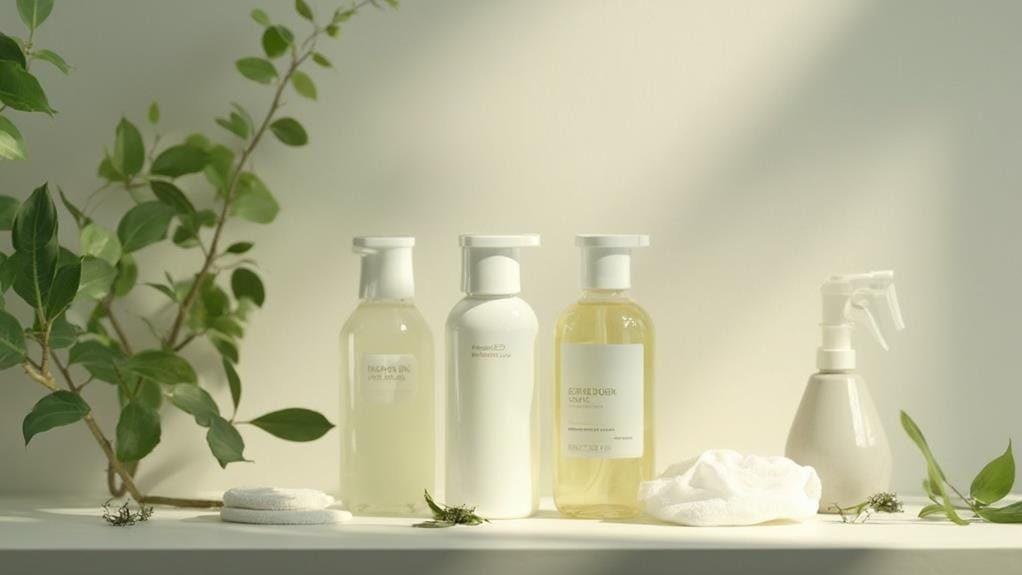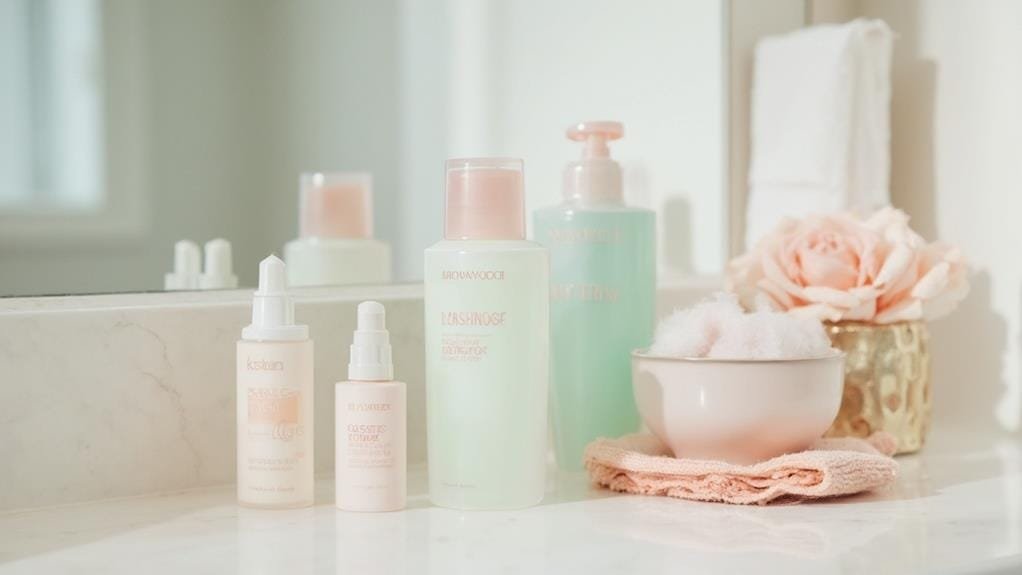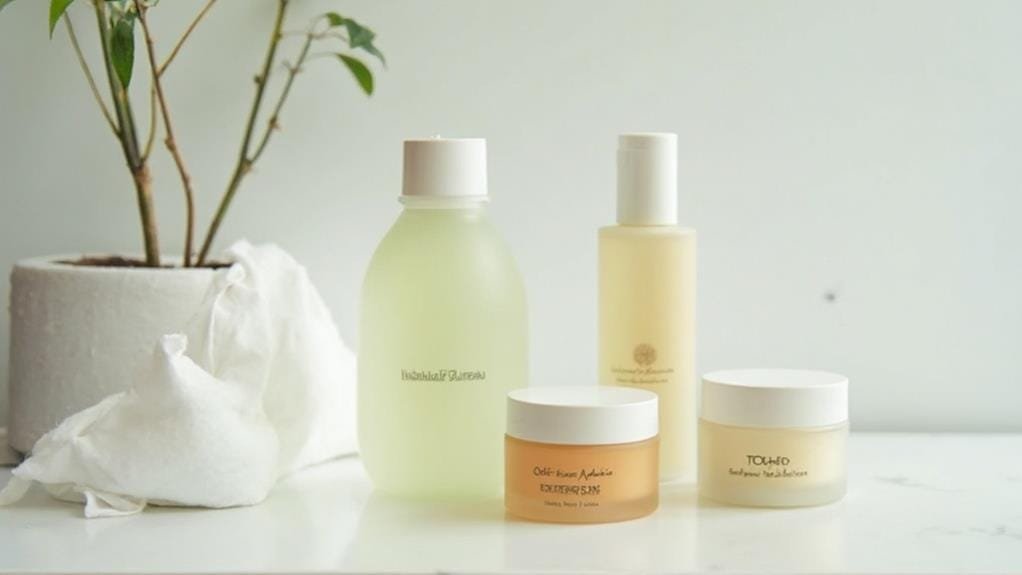You’re among the 40% of adults who struggle with oily skin, characterized by its shiny appearance and frequent breakouts. Managing oily skin requires a thoughtful approach to balance oil control and hydration. You may be tempted to use harsh products to strip away excess oil, but this can lead to dryness and irritation. Instead, a well-crafted skincare routine can help regulate oil production and achieve a healthier complexion. But what does this ideal routine look like, and which products should you prioritize? A closer examination of the key ingredients and daily care recommendations will reveal the answers. To start, a gentle cleanser formulated specifically for oily skin should be the foundation of your oily skin care routine. Look for a cleanser that contains salicylic acid or benzoyl peroxide to effectively remove excess oil and unclog pores without over-drying the skin. Following cleansing, a lightweight, oil-free moisturizer with ingredients like hyaluronic acid or glycerin can provide the necessary hydration without adding to the oiliness. Additionally, incorporating a targeted treatment, such as a mattifying primer or oil-absorbing powder, into your oily skin care routine can help control shine throughout the day.
Key Takeaway
- Cleanse oily skin twice daily with a non-drying, gel-based cleanser to remove excess oil and prevent clogged pores.
- Use an alcohol-free toner with salicylic or glycolic acid to minimize pores and prevent breakouts.
- Apply a lightweight, oil-free moisturizer morning and night to hydrate the skin without clogging pores.
- Exfoliate 1-2 times weekly with a salicylic acid-based product to prevent breakouts and maintain clear skin.
- Use a broad-spectrum sunscreen with at least SPF 30 daily to protect the skin from UV damage and control oil production.
Characterizing Oily Skin
When you look in the mirror, a shiny complexion stares back, particularly in the T-zone area of your forehead, nose, and chin. If this sounds familiar, you’re likely dealing with oily skin, characterized by excess sebum production. This skin type often leads to clogged pores, blackheads, and whiteheads, especially in the T-zone. But don’t worry, oily skin isn’t all bad news – it tends to appear thicker and can benefit from increased hydration, which can reduce the appearance of fine lines and wrinkles.
Hormonal fluctuations, particularly androgens, can play a significant role in determining your skin’s oil levels. If you notice a shiny appearance within 1-2 hours after cleansing, or if your makeup tends to slide off or look greasy throughout the day, it’s likely you have oily skin. Don’t stress – accurately identifying your skin type is the first step to tackling its challenges. By acknowledging your oily skin, you can begin to develop a skincare routine that caters to its unique needs and helps you achieve a clearer, healthier complexion. Understanding your skin is key, so let’s delve into and explore how to effectively manage your oily skin!
Key Skincare Ingredients
Tackling oily skin requires a solid understanding of the skincare ingredients that can help regulate oil production, reduce inflammation, and provide hydration without clogging pores. You’ll want to look for ingredients like salicylic acid, which exfoliates and prevents breakouts by dissolving excess oil and dead skin cells. Niacinamide is another powerhouse, regulating oil production and reducing inflammation while brightening and improving skin texture.
Hyaluronic acid is a must-have for oily skin, as it attracts moisture without adding extra oil. This powerful humectant provides long-lasting hydration, making it essential for oily skin moisturization. Retinol, a derivative of vitamin A, promotes cell turnover, minimizes fine lines and pores, and helps control oil production. When choosing products, opt for lightweight formulations like gels and serums that are non-comedogenic and oil-free. These won’t clog your pores or exacerbate oiliness. An oil-free moisturizer with hyaluronic acid is a great way to stay hydrated without adding extra oil. By incorporating these ingredients into your routine, you’ll be well on your way to balanced, healthy-looking skin. Remember, the right ingredients can make all the difference in managing oily skin.
Daily Care Recommendations

Every effective skincare routine starts with a solid daily care plan. For oily skin types, this means focusing on gentle, non-drying products that balance moisture levels while controlling excess oil. Here’s your daily care checklist:
- Cleanse wisely: Use a non-drying, gel-based cleanser, like CeraVe Foaming Facial Cleanser, twice daily to remove excess oil while preserving your skin’s moisture barrier.
- Tone up: Follow up with an alcohol-free toner containing salicylic or glycolic acid to help minimize pores and control oil production.
- Moisturize with protection: Apply a lightweight, oil-free moisturizer with broad-spectrum sunscreen, such as Ultra-Light Moisturizing Lotion with SPF 30, to hydrate and protect your skin from UV damage.
- Target concerns: Consider adding a Resurfacing Retinol Serum or serums rich in niacinamide to address uneven skin tone and improve skin texture.
Identifying and Adjusting
Now that you’ve got a solid daily care routine under your belt, it’s time to get real about your skin type – if you haven’t already, that is! To properly identify oily skin, pay attention to whether your skin looks shiny within a couple of hours of cleansing, especially in the T-zone, and if your makeup tends to slide off or get greasy by midday. By recognizing the telltale signs of oily skin, you can start making targeted adjustments to your skincare routine and product lineup to keep excess oil in check.
Oily Skin Characteristics
With a solid understanding of your skin type, you can better identify the characteristics that define oily skin. This skin type is marked by excessive sebum production, resulting in a shiny appearance, particularly in the T-zone, within a few hours after cleansing. Let’s break down the common features associated with oily skin:
- Excessive oiliness: Your skin tends to look shiny, especially in the T-zone, due to excess sebum production.
- Enlarged pores: Clogged pores from excess oil and dead skin cells can lead to larger pores, making your skin appear more textured.
- Blackheads and whiteheads: These skin concerns are common with oily skin, as pores can become clogged with oil, dead skin cells, and other debris.
- Makeup struggles: Your makeup may slide off or appear greasy by the afternoon, requiring frequent touch-ups.
It’s essential to recognize these characteristics to manage your oily skin effectively. By avoiding heavy, oil-based products and opting for lightweight, non-comedogenic formulations, you can help control excess sebum and reduce the appearance of enlarged pores. By understanding your skin’s unique needs, you can develop a skincare routine that addresses your skin concerns and leaves you with a healthy, balanced complexion.
Skincare Routine Adjustments
You’ve identified the characteristics of your oily skin; it’s crucial to adjust your skincare routine to address these concerns. When it comes to an oily skin routine, you’ll want to focus on finding a moisturizer for oily skin that’s lightweight and fast-absorbing. Look for products labeled “non-comedogenic” or “oil-free” to minimize clogged pores. Skincare ingredients like salicylic acid and niacinamide can help reduce the appearance of pores and control excess sebum production.
To make effective skincare routine adjustments, start by incorporating products containing these ingredients into your daily routine. Be patient and give your skin time to respond. If you notice persistent breakouts or increased shine, reassess your product usage and make adjustments as needed. Remember, everyone’s skin is different, so it’s vital to monitor your skin’s response to new products. Avoid heavy or oil-based products that can exacerbate oiliness, and consider consulting a dermatologist for personalized guidance on treatments and product selection tailored to your individual oily skin needs. By making these adjustments, you’ll be on your way to a balanced, healthy-looking complexion.
Product Selection Tips
A well-stocked skincare arsenal is essential for tackling oily skin concerns. To help your skin, you need to identify the right products that’ll remove excess sebum without stripping your skin of its natural moisture.
When shopping for products, keep these tips in mind:
- Opt for lightweight formulations: Choose gel-based cleansers and oil-free moisturizers that won’t clog pores or exacerbate oil production.
- Non-comedogenic is key: Select products labeled “non-comedogenic” or “oil-free” to guarantee they won’t block pores and cause comedonal acne.
- Steer clear of heavy oils: Avoid products containing heavy oils, which can worsen oiliness and irritation in oily skin.
- Ditch alcohol-based toners: These can dry out your skin and trigger more oil production, making your skin look greasier.
Essential Product Recommendations

Several key products can make or break an oily skincare routine. When it comes to cleansing, you’ll want to use a gel-based cleanser like CeraVe Foaming Facial Cleanser, which effectively removes excess oil without disrupting your skin’s natural moisture barrier. Next, hydrate your skin with a lightweight, oil-free moisturizer such as the Ultra-Light Moisturizing Lotion, which won’t clog pores or leave a greasy finish.
To really tackle oily skin, incorporate serums containing ingredients like niacinamide and hyaluronic acid, which calm the skin, retain moisture, and balance oil production. At night, use a Resurfacing Retinol Serum to refine skin texture and diminish post-acne marks. And don’t forget about sun protection – use a non-comedogenic sunscreen with at least SPF 30, like CeraVe Hydrating Mineral Sunscreen, to prevent UV-induced oil production.
These products will help you achieve the perfect balance of hydration and oil control. By using them consistently, you’ll be on your way to a clearer, more radiant complexion. Remember, the right products can make all the difference in your skincare routine, so choose wisely and get ready to glow!
Effective Skincare Routine
Your oily skincare routine is only as effective as the steps you take to care for your skin. To achieve healthy, balanced skin, it is crucial to follow a consistent daily routine that addresses your skin’s unique needs. Here’s a breakdown of the key steps to include:
- Cleanse twice daily: Use a gentle, non-drying gel-based cleanser to remove excess oil without disrupting your skin’s protective barrier.
- Tone and treat: Incorporate an alcohol-free toner with salicylic acid or glycolic acid to minimize pores and control oil production, while preventing breakouts.
- Moisturize: Apply a lightweight, non-comedogenic moisturizer both morning and night to maintain hydration without clogging pores.
- Protect with sunscreen: Apply a daily sunscreen with at least SPF 30 to protect against UV-induced oil production and support overall skin health.
Product Selection and Considerations

As you create your ideal skincare routine for oily skin, it’s important to choose products that’ll help control oil production and minimize pores. You’ll want to look for essential ingredients like salicylic acid, niacinamide, and retinol, which can make all the difference in achieving a balanced and radiant complexion. By selecting the right products and avoiding harsh ingredients, you’ll be one step closer to saying goodbye to greasy skin and hello to a fresher, more confident you.
Essential Ingredients for Oily
Five key ingredients take center stage when it comes to selecting products for oily skin. You’ll want to look for these power players to help control oil production, exfoliate pores, and maintain hydration.
Here are the top ingredients to keep an eye out for:
- Salicylic Acid: This beta-hydroxy acid penetrates pores to exfoliate and prevent breakouts, keeping your skin clear and radiant.
- Niacinamide: Not only does it regulate oil production, but it also soothes irritation and improves skin texture – a win-win for oily skin types.
- Hyaluronic Acid: This moisture magnet attracts hydration to the skin, balancing sebum levels without adding excess oil.
- Retinol: Enhancing cell turnover, retinol reduces the risk of congested pores and helps minimize fine lines and post-acne marks.
When shopping for products, also look for lightweight, non-comedogenic formulations that won’t clog pores or suffocate your skin. By incorporating these essential ingredients into your routine, you’ll be well on your way to balanced, healthy-looking skin that shines with a natural glow. By selecting products with these ingredients, you’re choosing a safer, more effective way to manage oily skin.
Harmful Ingredients to Avoid
There are other potentially damaging ingredients to watch out for as well. You’ll want to avoid products with fragrance and synthetic dyes, as they can irritate sensitive skin and trigger the skin to produce even more oil. Similarly, avoid products that contain menthol, mint, eucalyptus, or lemon, as they can cause tingling and irritation that worsens oily skin conditions.
Lastly, steer clear of harsh soap bars that strip the skin’s natural oils, leading to rebound oil production. Opt for gentle, lightweight liquids or gels instead. By steering clear of these harsh ingredients, you can keep your oily skin safe and on the road to recovery. Simply, stay vigilant about what you put on your face and watch out for those unwanted additives that can wreak havoc on your delicate skin.
Recommended Product Options
Selecting the right products is essential in maintaining healthy, balanced skin. You’ll want to choose a face wash that effectively removes excess oil without stripping your skin of its moisture. A gel-based cleanser is an excellent option, as it’s gentle yet effective. Here are some product recommendations to get you started:
- Gel-based cleanser: CeraVe Foaming Facial Cleanser or Cetaphil DERMACONTROL Oil Control Foam Wash are excellent choices for oily skin.
- Oil-free moisturizer: Look for non-comedogenic options like La Roche-Posay Effaclar Mat or CeraVe PM Facial Moisturizing Lotion to keep your skin hydrated without clogging pores.
- Exfoliating products: Incorporate Paula’s Choice 2% BHA Liquid Exfoliant a few times a week to help clear congestion and minimize the appearance of pores.
- Sunscreen: Apply a lightweight, oil-free sunscreen with at least SPF 30, such as Neutrogena Ultra Sheer Dry-Touch Sunscreen, daily to protect your skin from UV rays.
Remember to also look for products containing active ingredients like niacinamide, which helps with oil control and breakout prevention. By choosing the right products, you’ll be on your way to maintaining healthy, balanced skin that looks and feels its best.
Sunscreen and Outdoor Protection
Your outdoor adventures and daily commutes can take a toll on oily skin, especially if you’re not protecting it from the sun’s harsh rays. That’s why daily sunscreen application is a must! Look for a broad-spectrum sunscreen with a minimum SPF of 30 to shield your skin from UV damage while keeping oil production in check. Non-comedogenic sunscreens, typically in gel or cream form, are your best bet as they hydrate without clogging pores, helping you maintain a matte finish.
Opt for physical sunscreens containing zinc oxide or titanium dioxide, which provide effective protection without irritating oily skin. Research shows that consistent sunscreen use not only prevents skin damage but also helps control oiliness and reduces acne formation by protecting the skin barrier. Don’t forget to reapply sunscreen every two hours, especially during outdoor activities, to maintain skin protection and prevent breakouts from sweat and oil accumulation. By making sunscreen a priority, you’ll be protecting your skin from the sun’s harsh effects while keeping oiliness under control. So, slather on that sunscreen and enjoy the great outdoors with confidence!
Long-Term Management Strategies

Managing oily skin requires a long-term approach, building on the daily habits and product choices you’ve already established. To achieve a balanced skin barrier, incorporate these four essential long-term management strategies into your daily skincare routine:
- Consistent cleansing and moisturizing: Stick to a gentle, non-comedogenic cleansing routine, and use oil-free moisturizers or gels to maintain hydration without clogging pores.
- Exfoliate wisely: Regularly exfoliate 1-2 times a week with products containing salicylic acid (BHA) to eliminate dead skin cells and prevent breakouts.
- Harness the power of active ingredients: Incorporate products containing niacinamide, which helps control excess oil and improves skin texture over time.
- Stay on track with professional guidance: Periodically consult with a dermatologist to adapt your skincare routine based on changing skin conditions or concerns, ensuring your daily skincare routine remains effective and safe.
Frequently Asked Questions
What Is the Best Face Routine for Oily Skin?
You’re on the hunt for the perfect face routine for oily skin! Start by harnessing the power of exfoliation benefits with a gentle, chemical-based exfoliant containing salicylic acid. Next, indulge in clay masks once or twice a week to detoxify and purify your pores. Choose oil-free moisturizers that won’t clog pores, and don’t forget sun protection with a broad-spectrum sunscreen. Be mindful of dietary impacts on your skin, and for added protection, stay hydrated and aware of ingredients in your products.
Which Is Best Face for Oily Skin?
Imagine a radiant, oil-free complexion – it’s achievable with the right skincare products! For oily skin, look for lightweight, non-comedogenic facial cleansers that maintain moisture balance while minimizing pores. Acne treatments with salicylic acid or benzoyl peroxide help control breakouts. Don’t forget oil-control moisturizers and broad-spectrum sunscreen options with at least SPF 30. With these products, you’ll be on your way to a shine-free, healthy glow that lasts all day!
Is Serum Necessary for Oily Skin?
You might be wondering if serum is necessary for oily skin. The answer is yes! A serum can be a game-changer, offering oil control and moisturizing essentials. Focus on ingredients like niacinamide or salicylic acid, which help regulate sebum and prevent breakouts. Apply a lightweight, non-comedogenic serum before moisturizing for best results. By incorporating a serum into your everyday routine, you’ll enhance skin compatibility and achieve a clearer, healthier complexion.
What Consistency Is Best for Oily Skin?
Did you know that 75% of people with oily skin use the wrong products, exacerbating the issue? To combat this, you’ll want to focus on lightweight formulas with gel textures or oil-free options. Look for moisturizer types labeled “non-comedogenic” and hydrating mists to balance your skin. Exfoliate 1-2 times a week and use balancing toners daily. Ingredients like salicylic acid and niacinamide will be your BFFs, providing benefits without clogging pores. Your skin will thank you!
Conclusion
You’ve got the lowdown on the ideal skincare routine for oily skin! By incorporating a balanced approach that controls excess oil while maintaining hydration, you’ll be on your way to healthy, clear skin. Did you know that using a broad-spectrum sunscreen with at least SPF 30 daily can reduce your risk of premature aging by 24%? Stick to your routine, make adjustments as needed, and get ready to glow with confidence!





